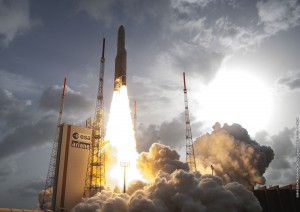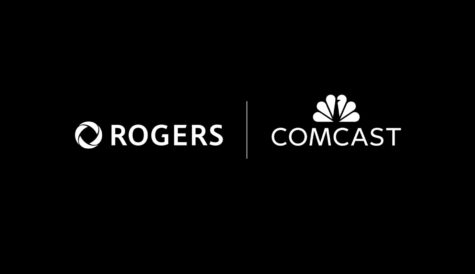Up in the air: The future of satellite TV
Cheaper high-bandwidth broadband and growth in non-linear viewing has continued to cast doubt on the future of satellite TV, but satellite as a distribution technology has proved surprisingly resilient. Stuart Thomson reports.
In a world where OTT TV providers are setting the agenda, there is a growing sense that linear TV is on the way out and on-demand and multiscreen is the future of video. This has been fuelled by the likes of Netflix CEO Reed Hastings, who has argued that broadcasters will become internet networks as the traditional TV industry goes the way of the fixed-line phone business. According to Hastings the time will come when the concept of a scheduled linear broadcast will seem quaint and alien.
The death of broadcast would also imply the demise of infrastructure providers that support it, such as satellite. For the satellite industry, the long term prospects for the video business rest on overcoming or offsetting two key challenges.
The first of these is the falling price of terrestrial bandwidth, which over time could make it more viable for content providers – beginning with those targeting relatively small niche audiences – to distribute linear channels over terrestrial fixed or even wireless networks, including delivering direct to their consumers as OTT services.
The bandwidth battle
The second is the expectation over time that people will consume video in a multiplicity of different ways, viewing most content on-demand, and on devices such as tablets and smartphones. In this case, not only does satellite lose the key advantage of its one-to-many capability, but it also faces the challenge of delivering video to an untethered tablet rather than a TV plugged into a set-top box.
The question of how competitive satellite is likely to be with fixed terrestrial networks has been much discussed over the past few years, with little consensus over projections.
While the cost of terrestrial distribution has fallen and bandwidth has increased, making networks ‘video-ready’ with high reliability has proved complex. Satellite technology has also moved on, with new modulation technologies and ongoing improvements in video compression – including the availability of the H.265/HEVC format – helping to keep satellite relevant. Satellite also benefits from its ability to distribute content to an infinite number of end points.
“The one-to-many strength of satellite still beats other infrastructures, especially to rural areas where DTH has historically been strong,” says Ole Ledang, divisional director of broadcast services at Telenor Satellite. “Our main task it to make sure our DTH customers succeed in the marketplace. The challenge for DTH operators is to create the best possible user experience for customers in competition with OTT and the likes of Netflix.”
For Ledang, the competitiveness of satellite versus CDN-based distribution of content can’t be determined by a fixed formula. The development of technology means the relative costs associated with each are changing constantly. He points to evolving modulation technologies that improve the efficiency with which satellite can deliver video content and other data, meaning that satellite can continue to compete with terrestrial delivery costs. While some niche channels may switch to broadband, the advantages of doing so only apply “up to a certain limit”, he says.
Satellite operators are adopting a range of ways to ensure that they stay competitive, including, in Telenor’s case, the sharing of capacity across multiple services. “In addition to providing turn-key solutions to our DTH customers – including OTT services and advanced monitoring – we are actively promoting and facilitating channel sharing,” says Ledang. “On our path to ensure that we do what we can in order to make our customers successful in their marketplace, establishing cost-effective solutions is extremely important. The ultimate position is that the DTH operators on [Telenor’s prime slot at] 1° West share all content which is common – by including simulcrypt on the services. We do provide such services for UPC and Canal Digital today, and UPC also shares content with other 1° West distributors.” The result of channel-sharing, he says, is that “the DTH operators reduce their transmission cost, hence are able to spend a larger portion of their budget on exclusive content – which I think will be increasingly important going forward.”
Satellite operator Eutelsat’s vice-president of global sales and commercial development, Christophe Limmer, meanwhile says that satellite will remain the leading video infrastructure in emerging markets in Africa, Latin America, the Middle East and “even parts of eastern Europe”.
Limmer said that OTT services – even high-profile ones – still suffer from certain weaknesses vis-à-vis broadcast channels, including network reach and quality, with sufficient bandwidth simply not available in some markets.
“We do have changes in consumer behaviour. We have fast growing consumption on other screens. OTT services now play an important role but these services also have weaknesses. One is network reach and quality,” he says, pointing out that only one household in 10 in South Africa is capable of receiving Netflix streams. There is also a cost advantage that comes with scale. “With growing numbers of users you also have growing distribution costs, whereas satellite is always the same price,” says Limmer.
Limmer believes the advent of bandwidth-hungry UHD TV will give a boost to satellite, which can deliver it more efficiently than terrestrial networks and with more consistent quality. “We will lose some channels that will go down the OTT route but the growth we will have in terms of new formats like UHD will compensate for the relatively low number of channels that we will lose,” he says.
Spacecom, another satellite operator with a strong presence in emerging markets, also holds that satellite still has multiple opportunities for growth. “Satellite operators will continue to be the backbone for DTH providers. Viewers are continuing to watch TV and to take advantage of other DTH services. As long as quality and bandwidth are best on satellite, satellite will continue its major role with DTH operators,” says a confident Doron Elinav, vice-president, market development at the Israel-based satellite operator. “Satellite technology has an advantage whenever content needs to broadcast to millions of viewers and, for that reason, we are confident that satellite TV will continue to serve as the mainstream for the delivery of TV services.”
Elinav says that satellite can add new services – such as UHD TV – more rapidly and efficiently than cable and other terrestrial infrastructures. “We expect to see satellite at the forefront of these upgrade cycles that occur every few years in the future as well,” he says.
For Elinav, the multicast advantage of satellite over rival network types is “huge, especially in less developed regions, or regions of low population density”, while multichannel platforms in prime satellite orbital locations “make the advantage of satellite for TV even more pronounced”.
Peter Ostapiuk, vice-president, media product management at Intelsat, agrees, pointing out that “in many areas broadband connectivity won’t be sufficient in the near term to support effective streaming”. Ostapiuk, like Elinav, believes that new services such as UHD TV – as well as ongoing migration to HD – will benefit satellite. In addition to broadband in many regions not being up to the job of supporting streaming, consumers look to existing – primarily satellite-based – pay TV players for the “convenience of one platform”, he says.
Ostapiuk admits that in some emerging markets – notably Africa – mobile could offer a significant alternative to DTH. However, satellite will still be the most efficient way of transporting video to cellular towers, he adds.
David Crawford, managing director of satellite and media at broadcast services provider Arqiva, agrees that prospects for linear satellite TV vary between regions. One key concern, he says, is the need to get better data on how media is consumed, which is feeding not only into how money is made from services but how the content is paid for.
Overall, he admits there is a slow movement of channels to OTT delivery as high-speed broadband becomes available more widely. Improvements in the efficiency and ability of satellite to deliver better bandwidth are not as rapid as is the case with terrestrial networks. Nevertheless, he says, “satellite has a big advantage in broadcasting to many viewers”. At the end of the day, for niche-interest channels, whether to go with OTT or stick with satellite depends on “how big is their niche”, he says.
On-demand
Growth in non-linear viewing has led satellite broadcasters and TV operators – whether pay TV or free – to look to hybrid delivery to satisfy the expectations of their customers, for example by developing services based on the HbbTV standard or a proprietary system.
Eutelsat has been involved in a number of projects to combine multiscreen on-demand services with satellite broadcasting. It has worked with French free-to-air satellite platform Fransat to deliver on-demand services to Fransat users. The Fransat Connect platform makes use of the HbbTV standard to provide access to the catch-up services of the channels on the platform. Limmer says that Eutelsat is also looking to deliver push VoD services using the HbbTV standard.
Ledang says that Telenor Satellite has made an effort to stay competitive with terrestrial networks, encoding content received at its facility and re-encoding it in “whatever format” customers want for delivery over CDNs as well as satellite.
For most satellite TV customers, hybrid delivery seems to work well. UK free-to-view satellite platform Freesat has seen strong take-up of its Freetime offering, which includes access to a range of broadband-delivered on-demand apps via a tightly integrated user experience. For Matthew Huntingdon, chief technology officer at Freesat, there is relatively little difference between providing hybrid services for satellite as for digital-terrestrial TV – exemplified by the fact that the Irish broadcaster RTÉ is using the platform to supply its forthcoming Saorview Connect service.
“That proposition with RTÉ is one we are taking around globally to operators to propose to them, so they can move from being a pure linear broadcaster to offering a hybrid play where they are putting together on-demand services with broadcast services,” says Huntingdon. “At the end of the day, an app on our service or an HbbTV app does not care whether the delivery mechanism for linear TV is terrestrial, satellite or cable. Obviously the set-tops are not the same but today’s modular hardware means that swapping out tuners is not much effort. We are mainly talking to satellite operators but that is partly because we are a satellite operator and have relationships with other satellite operators. It doesn’t mean that the opportunity is not equally valid for terrestrial operators.”
For Huntingdon, the key value of what Freesat offers is its EPG and user experience, backed by effective management of metadata and editorialised recommendations. Content providers could theoretically deliver linear services over broadband to connected boxes and those channels could appear in the EPG.
“The most effective way to find content is via the EPG listing. That listing is very powerful. It may be that broadcasters can’t afford to deliver content over satellite, and we welcome channels being delivered over IP,” he says. Nevertheless, channel providers – for now at least – have focused on reaching the large potential base of satellite viewers rather for a one-off cost. “People get more eyeballs on satellite,” says Huntingdon. “If everyone connected their TV to the internet then the cost might well be the same or cheaper on OTT as on satellite, but that‘s not the case today. You reach a bigger niche market by broadcasting than by delivering over OTT.”
This preference is reinforced, says Huntingdon, by the fact that most viewers still prefer to watch content on the largest screen available to them – generally the one in the living room attached to a set-top box.
“Our research and research by the BBC and others has shown is that people watch TV on the biggest screen available to them at the time they are watching,” he says. “One thing that has challenged that is that BBC iPlayer is mostly used on mobile devices now, but the really interesting thing is that at Christmas there was a change where the biggest chunk of viewing of iPlayer was on connected TV devices like game consoles or operator devices.” He suggests that this change could be driven by a growing awareness that the BBC’s popular catch-up service can be accessed via the TV.
Satellite-only solutions
While on-demand and multiscreen services are typically delivered via a terrestrial broadband connection to complement the satellite-delivered broadcast channels, Eutelsat and others are also working on satellite-based solutions to deliver content to multiple devices via the satellite set-top box. Eutelsat’s Project Canaletto is designed to enable the delivery of satellite-delivered linear and on-demand content to IP-native screens. Canaletto Live enables the deliver of live broadcast streams to multiple devices, while content can also be pushed to hard drive-enabled devices, enabling the delivery of VoD services without a permanent terrestrial return. An Android app is under development that can be integrated with existing mobile apps provided by broadcasters.
The live linear product sends IP-native channels to mobile screens with guaranteed QoS, according to Limmer. “It is comparable with terrestrial delivery,” he says. The on-demand push functionality “allows you to have on-demand content irrespective of whether you are connected to the internet”, with content received via satellite multicast and then distributed as IP streams around the consumer’s premises.
Return-channel commands and audience data are sent via terrestrial networks. ‘We are testing this with selected broadcast customers and we are working with them to find a suitable business,” says Limmer.
Eutelsat has also developed satellite-only solutions to enable the delivery of non-linear content to residential and commercial customers. The operator’s Smart LNB initiative was designed to create a next-generation single-block LNB that could deliver a return path via satellite, enabling consumers to access push VoD, pay-per-view, social TV features, HbbTV apps and multiscreen viewing without the need for a terrestrial connection. Smart LNB currently requires a separate indoor unit (IDU) that connects the LNB of the dish with devices, but Eutelsat is also working on an integrated set-top version.
“The advantage of the Smart LNB is, on one hand, you have a permanent exchange [between the operator] and the way the consumer watches TV. A lot of [our] customers want to use it for audience measurement purposes. It simplifies payment for VoD purposes,” says Limmer. One of the great points about the smart LNB is that it delivers a unified experience – via satellite.
On top of these initiatives, Eutelsat has also teamed up with its main rival, Luxembourg-based SES, to work on what the pair have dubbed the Future Video Initiative, which is designed to combine satellite and IP technology. “Not only are the satellite operators aligned but the telecom operators are too. If they want to provide the best user experience, they also have to use satellite as part of the chain to ensure that what they have an offer is always available and can be received by the whole population,” says Limmer.
Intelsat’s Ostapiuk also believes that two-way satellite technologies have a significant future, not only for interactive TV applications but to deliver content to a range of destinations, including cell towers, WiFi kiosks and small businesses. “For interactivity, I think transactional VoD delivered over two-way satellite can be done – the cost of two-way satellite has decreased. A lot of those set-top boxes also have technology that allows a return path over wireless or wired broadband as well – I think those technologies are really relevant and will drive applications like push-VoD,” he says.
Intelsat is in the process of building a fleet of high-throughput satellites – dubbed EPIC NG – which are primarily intended to target broadband and mobility markets rather than TV. However, Ostapiuk says that the current satellite replacement cycle will enable frequency re-use via targeted spot-beams. This, he says, will “allow us to optimise the payloads and design the beams used for DTH operators”. He says that this will enable Intelsat to “design payloads specifically for our customers and for interactive two-way IP” services.
Not everyone is convinced by the power of satellite-only delivery of non-linear applications. “I’m not positive about pure satellite solutions. They take away one-to-many, and removing the main benefit of satellites,” says Telenor’s Ledang. “To create one-to-one or one-to-a- few links in competition, say with LTE, the satellite capacity will be too expensive and the end user equipment will be challenged to genuinely provide two-way communications.”
Arqiva’s Crawford also strikes a note of mild scepticism, pointing out that the Sat>IP technology developed by SES has yet to be adopted by high-profile customers with advanced multiscreen services such as Sky, which recently launched its next generation Sky Q service.
In addition to delivering their own on-demand and multiscreen video services, larger pay TV operators are looking to deliver a full suite of multiplay services, bundling internet and phone access in with TV.
It is possible for satellite to provide a comprehensive multi-play offering, with operators delivering data via satellite as well as TV. Because of the costs of satellite-delivered broadband, this is very much seen as a niche offering and has been regarded primarily as a small-business focused service for areas with poor terrestrial connectivity. However, Spacecom’s Elinav at least is quite bullish about its prospects. While admitting that satellite broadband is currently a “niche play”, he says that cheaper satellite data via high-throughput satellites will enable operators “to provide a gap-filling solution”, leading to a growing market for satellite in this sphere. In regions with poor or non-existent terrestrial infrastructure, he says, high-speed internet to non-urban areas is very likely to be “first via satellite”. In some markets, he says, HTS platforms could also be used to deliver a wide range of TV services.
“HTS opens up new markets for the satellite industry and enables integration of linear and non-linear services by DTH to its customers,” he says. “Spacecom is making its entry to the HTS world with Amos-6, which has high-throughput beams over Africa and Europe. We expect to have additional HTS payloads in the future, and integrating broadband services for non-linear content with broadcast services for linear content is one path to enabling a future-proof satellite delivered TV service, regardless of which path it will take.”
Growth story
Generally, satellite operators believe growth from pure video distribution will continue.
Telenor Satellite’s Ledang says that the number of channels will continue to expand, with pan-regional feeds splitting into territory-specific feeds to build better advertising revenues, while broadcasters will also look to deliver an ever-greater number of feeds from high-profile events such as the Olympics.
Eutelsat’s Limmer points out that satellite is still growing at a time when cable TV has stalled. He believes that UHD video will mean many broadcasters and content providers will have no choice but to turn to satellite. “Doing 4K on a terrestrial network is challenging, and when it comes to delivering a huge number of channels, satellite will remain the most relevant infrastructure,” he says.
For Ostapiuk, Intelsat is looking to DTH to expand its overall business, with that increase coming from a mix of organic growth in platforms, growth driven by technology changes such as HEVC, the emergence of new business models, growth in supplementary services such as push-VoD delivered over the satellite link, and greater use of satellite by broadcasters for disaster recovery.
“What I see in the market in terms of channel growth is not the numbers going up but HD and UHD picking up steam. We see strong signs of premium UHD content picking up. Internationally in addition to UHD, there is still a significant room for growth with HD channels. There are also significant efforts to regionalise premium content, moving from pan-regional feeds to country-specific feeds,” he says.
The operators’ optimism seems, up until now, to be borne out by the facts. Talk about non-linear viewing and the appeal of internet delivery may be based in fact, but it is also true that, for much of the planet, watching linear TV remains a major leisure activity.




